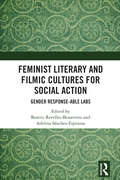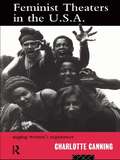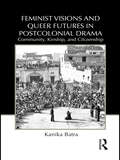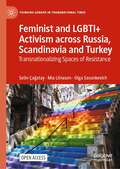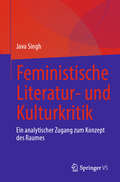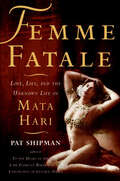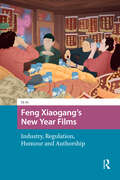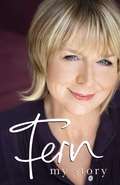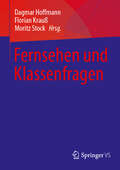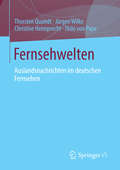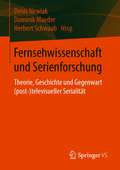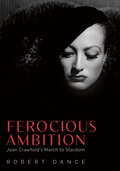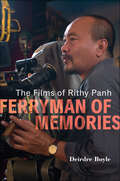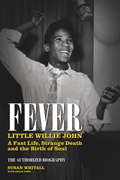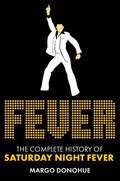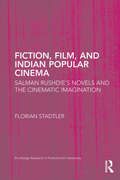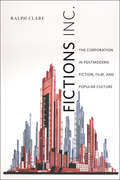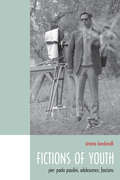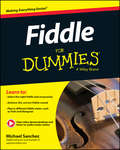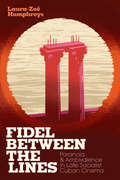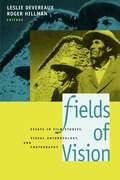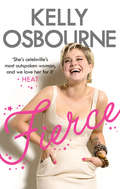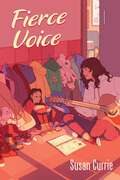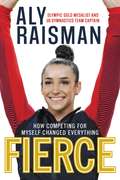- Table View
- List View
Feminist Literary and Filmic Cultures for Social Action: Gender Response-able Labs
by Beatriz Revelles-Benavente Adelina Sánchez-EspinosaFeminist Literary and Filmic Cultures for Social Action: Gender Response-able Labs examines teaching and research practices under feminist new materialisms, affect theories and response-ability through literary and visual products, and offers possible bridges between academia and activism to create feminist interventions in contemporary neoliberal structures.Featuring chapters from contributors across a wide range of disciplines, this book follows a methodological framework that blends traditionally opposite categories, such as theory and practice, and explores contemporary literature and films as case studies within innovative “feminist response-able labs”.In Feminist Literary and Filmic Cultures for Social Action readers will encounter a collaborative trans-disciplinary toolbox which can be of use to multiple disciplines and an invaluable resource to advanced undergraduate students, postgraduate researchers and scholars in literary studies, film studies, feminist theories, new materialisms, and affective pedagogies
Feminist Theatres in the USA: Staging Women's Experience (Gender in Performance)
by Charlotte CanningFeminist Theaters in the USA is a fresh, informative portrait of a key era in feminist and theater history It is vital reading for feminist students, theater historians and theater practitioners. Their continued movement forward will be challenged and enriched by this timely look back at the trials and accomplishments of their predecessors. Canning interviews over thirty women who took part in the dynamic feminist theater of the 1970s and 1980s. They provide first-hand accounts of the excitement, struggles and innovations which formed their experience. From this foundation Cannning constructs a compelling combination of historical survey, critique and celebration which explores: * The history of the groups and their formation * The politics which shaped their work * Their methods and creative processes * The productions they brought to the stage * The reception from critics and audiences
Feminist Visions and Queer Futures in Postcolonial Drama: Community, Kinship, and Citizenship (Routledge Advances In Theatre And Performance Studies #17)
by Kanika BatraIn this timely study, Batra examines contemporary drama from India, Jamaica, and Nigeria in conjunction with feminist and incipient queer movements in these countries. Postcolonial drama, Batra contends, furthers the struggle for gender justice in both these movements by contesting the idea of the heterosexual, middle class, wage-earning male as the model citizen and by suggesting alternative conceptions of citizenship premised on working-class sexual identities. Further, Batra considers the possibility of Indian, Jamaican, and Nigerian drama generating a discourse on a rights-bearing conception of citizenship that derives from representations of non-biological, non-generational forms of kinship. Her study is one of the first to examine the ways in which postcolonial dramatists are creating the possibility of a dialogue between cultural activism, women’s movements, and an emerging discourse on queer sexualities.
Feminist and LGBTI+ Activism across Russia, Scandinavia and Turkey: Transnationalizing Spaces of Resistance (Thinking Gender in Transnational Times)
by Mia Liinason Olga Sasunkevich Selin ÇağatayWhat do struggles for women’s and LGBTI+ rights in Russia, Turkey and the Scandinavian countries have in common? And what can actors who struggle for rights and justice in these contexts learn from each other? Based on a multisited ethnography of feminist and LGBTI+ activisms across Russia, Turkey and the Scandinavian countries, this Open Access book explores transnational struggles on various levels, from the micro-scale of the everyday to large-scale, spectacular events. Drawing on ethnographic insights and encounters from various sites, this book conceptualizes resistance as situated in the grey zone between barely perceptible, even hidden or covert, forms of mundane activist practices and highly visible street protests, gathering large crowds. Taking the reader beyond the dichotomies of visible/invisible and public/private, this book advances new understandings of resistance, solidarity, and activism in transnationalizing feminist and queer struggles, illustrated by rich ethnographic case studies from Russia, Scandinavia and Turkey.
Feministische Literatur- und Kulturkritik: Ein analytischer Zugang zum Konzept des Raumes
by Java SinghFeministische Literatur- und Kulturkritik erforscht interdisziplinäre Verbindungen zwischen Kulturanthropologie, Geographie, Psychologie und feministischer Literaturkritik, um einen theoretischen Rahmen für Raumkritik zu entwickeln. Anhand des im Buch entwickelten Rahmens der räumlichen Gynokritik werden ausgewählte Texte aus fünf verschiedenen Genres - Kurzgeschichte, Roman, Film, Zeichentrickfilm und OTT-Serie - analysiert, die von Frauen verfasst wurden. Die in dem Buch behandelten Autorinnen bilden eine transnationale Gemeinschaft von Frauen, die gemeinsame Anliegen in Bezug auf Geschlecht, Umwelt, Technologie und soziale Hierarchien teilen. Es handelt sich um eine geografisch und sprachlich vielfältige Gruppe aus Indien, Uruguay, Spanien, Argentinien und den USA. Das Buch bietet ein immenses Potenzial für eine vergleichende Studie zu zahlreichen Aspekten, von denen sich die vorliegende Arbeit auf die Behandlung des Themas Raum konzentriert und zeigt, dass räumliche Logik undGrammatik wesentliche Elemente der feministischen Praxis sind. Das Buch offenbart das ungeprüfte Potenzial der Praxis der Schöpferinnen, die zugeschriebenen Zentren, um die herum die sozialen Arrangements strukturiert sind, zu destabilisieren, zu dezentrieren und zu zerstören. Darüber hinaus bietet das Buch wertvolle Analyseinstrumente, die die Literaturtheorie, die vergleichenden Kulturwissenschaften, die vergleichende Literaturwissenschaft, die Geschlechterforschung, die feministische Kritik und die interdisziplinären Geisteswissenschaften bereichern. Es ist ein unverzichtbares Hilfsmittel für Studierende und Lehrende in diesen Studienbereichen, das es ihnen ermöglicht, Texte aus einer neuen Perspektive zu betrachten.
Femme Fatale: Love, Lies, and the Unknown Life of Mata Hari
by Pat Shipman“An engrossing biography” of the Dutch exotic dancer accused of being a spy for the Germans during World War I.In 1917, the notorious Oriental dancer Mata Hari was arrested on the charge of espionage; less than one year later, she was tried and executed, charged with the deaths of at least 50,000 gallant French soldiers. The mistress of many senior Allied officers and government officials, even the French minister of war, she had a sharp intellect and a golden tongue fluent in several languages; she also traveled widely throughout war-torn Europe, with seeming disregard for the political and strategic alliances and borders. But was she actually a spy? In this persuasive new biography, Pat Shipman explores the life and times of the mythic and deeply misunderstood dark-eyed siren to find the truth.Praise for Femme Fatale“Her life’s story is a humdinger.” —Washington Post Book World“Pat Shipman reasons (and writes) like a born counterintelligence officer. Her gripping and well-developed account of the famed spy . . . will fascinate you right down to her grim imprisonment and hast execution in a desolate field outside Paris, her last performance faced, as were all of her life’s twists and turns, with bravery and grace.” —Peter Earnest, Executive Director, International Spy Museum, Washington, D.C., and former CIA Operations Officer
Feng Xiaogang’s New Year Films: Industry, Regulation, Humour and Authorship (Asian Visual Cultures)
by Qi AiThis book offers not only an in-depth study of Feng Xiaogang as a cinematic auteur but also a comprehensive and informative discussion of the industrial transformation of mainstream Chinese cinema under party-state regulation from the 1990s to the 2010s. It argues that Feng is not simply a commercially and artistically successful auteur but also a strategist who manages to achieve such success by his ability to negotiate governmental and market expectations. The negotiation facilitates his New Year filmmaking and dynamically affects the textual form of the resulting works. Feng engages in this textual construction, through which he delivers his own interpretations of the Chinese film industry’s state-led commercialisation, cultural policy, film regulation, and even political campaigns, establishes his authorship and restores his creative authority. Through this book, readers will comprehend the edges and limitations of auteur studies in order to understand the current cultural landscape of the film industry.
Fern: My Story
by Fern BrittonThe much-loved TV star Fern Britten tells her story for the first time in her Sunday Times bestselling memoir.For years now, Fern Britton has been widely loved as the presenter ofReady Steady Cook, and, more recently, co-presenter of This Morning with Philip Schofield. Never one to shy away from a good laugh or cry on national TV, she has none-the-less never talked about herself to the public, preferring to keep her private life private. Her warmth and humour, empathy and compassion, have made her feel like a best friend to millions on a daily basis, but no one knows the woman behind the sparkling smile.Now, for the first time, she is going to tell her story. And it is one that will strike a chord with women everywhere. Life as a child was not always easy, and she faced private and public challenges with her personal life, appearance and her career as she climbed the ladder to fame. Now a full-time working mum, with a very happy marriage to her second husband Phil Vickery, she is at the top of her game, and ready to tell it like it is. So put your feet up and get ready for a great read with Fern Britten.Fern Britten grew up in Buckinghamshire, and started her career on Westward Television, before moving to GMTV and Ready Steady Cook. She later co-presented This Morning with Philip Schofield, and has become a much sought after presenter for shows including Have I Got News For You, Soap Star Superstar and Celebrity Mr and Mrs. She recently wowed audiences with her performance on Strictly Come Dancing. She lives in Buckinghamshire with her husband Phil Vickery and their four children.
Fernsehen und Klassenfragen
by Dagmar Hoffmann Florian Krauß Moritz StockDer Sammelband untersucht das Verhältnis von Klasse – einer nicht nur ökonomischen, sondern auch kulturellen und politischen Kategorie – und dem Fernsehen in seinen gegenwärtigen hybriden Formen vor allem aus vier Perspektiven: Erstens geht es um Klassenfragen im Fernsehen, auf der Ebene der Repräsentation, zweitens um Klassenfragen des Fernsehens auf der Seite der Produktion. Hier ist zum Beispiel zu analysieren, welche Klassen welches Fernsehen (für welche Klassen) entwickelt und herstellt. Unter drittens Klassenfragen beim Fernsehen fallen Beiträge, die sich auf die Seite der Rezeption fokussieren und zum Beispiel die Lesarten zu spezifischen Klassendarstellungen beleuchten. Viertens nimmt der Band Klassenfragen der Fernsehwissenschaft in den Blick und reflektiert in diesem Zusammenhang ihre Lücken und ihre Prägung durch Klassenzugehörigkeit.
Fernsehwelten
by Thorsten Quandt Jürgen Wilke Christine Heimprecht Thilo PapeDer Band vermittelt ein eindrückliches Bild vom Stand der Auslandsberichterstattung im deutschen Fernsehen. Auf der Basis inhaltsanalytischer Untersuchungen, einer Repräsentativbefragung unter deutschen Fernsehzuschauern sowie Leitfadeninterviews mit Journalisten aus den produzierenden Redaktionen werden die Erkenntnisse eines umfassenden Projekts zur Erforschung der Auslandsnachrichten im deutschen Fernsehen diskutiert.
Fernsehwissenschaft und Serienforschung: Theorie, Geschichte und Gegenwart (post-)televisueller Serialität
by Dominik Maeder Denis Newiak Herbert SchwaabFernsehserien erfreuen sich einer ungebrochenen - populären wie wissenschaftlichen - Aufmerksamkeit. Dabei erstaunt, dass in medien- und kulturwissenschaftlichen Arbeiten zur Serialität fernsehwissenschaftliche und -geschichtliche Ansätze noch immer eine eher kleine Rolle spielen. Dabei ist Serialität stets vom Fernsehen her zu denken, sind doch beide schon immer unauflösbar miteinander verwoben gewesen – ökonomisch, technisch und ästhetisch. Doch was macht darüber hinaus das Serielle im Fernsehen aus und wie verändert es sein Gesicht in Zeiten von Digitalisierung, Streaming und Interaktivität? Lässt sich eine genuine Serientheorie des Televisuellen denken – und was lässt sich daraus wiederum für die Serialität jenseits des Fernsehens lernen? Die fernsehwissenschaftlichen Aufsätze dieses Bandes leisten einen Beitrag dazu, das Serielle als Kernprinzip des Fernsehens neu zu beleuchten und anhand vielfältiger Beispiele aus dem aktuellen Fernsehserienangebot neue Impulse für eine Fernsehtheorie des Seriellen zu setzen.
Ferocious Ambition: Joan Crawford’s March to Stardom
by Robert DanceRobert Dance’s new evaluation of Joan Crawford looks at her entire career and—while not ignoring her early years and tempestuous personal life—focuses squarely on her achievements as an actress, and as a woman who mastered the studio system with a rare combination of grit, determination, beauty, and talent.Crawford’s remarkable forty-five-year motion picture career is one of the industry’s longest. Signing her first contract in 1925, she was crowned an MGM star four years later and by the mid-1930s was the most popular actress in America. In the early 1940s, Crawford’s risky decision to move to Warner Bros. was rewarded with an Oscar for Mildred Pierce. This triumph launched a series of film noir classics. In her fourth decade she teamed with rival Bette Davis in Whatever Happened to Baby Jane?, proving that Crawford, whose career had begun by defining big-screen glamour, had matured into a superb dramatic actress. Her last film was released in 1970, and two years later she made a final television appearance, forty-seven years after walking through the MGM gate for the first time. Crawford made a successful transition into business during her later years, notably in her long association with Pepsi-Cola as a board member and the brand’s leading ambassador. Overlooked in previous biographies has been Crawford’s fierce resolve in creating and then maintaining her star persona. She let neither her age nor the passing of time block her unrivaled ambition, and she continually reimagined herself, noting once that, for the right part, she would play Wally Beery’s grandmother. But she was always the consummate star, and at the time of her death in 1977, she was a motion picture legend and a twentieth-century icon.
Ferocious Reality: Documentary according to Werner Herzog (Visible Evidence #27)
by Eric AmesOver the course of his career Werner Herzog, known for such visionary masterpieces as Aguirre: The Wrath of God (1972) and The Enigma of Kaspar Hauser (1974), has directed almost sixty films, roughly half of which are documentaries. And yet, in a statement delivered during a public appearance in 1999, the filmmaker declared: &“There are deeper strata of truth in cinema, and there is such a thing as poetic, ecstatic truth. It is mysterious and elusive, and can be reached only through fabrication and imagination and stylization.&” Ferocious Reality is the first book to ask how this conviction, so hostile to the traditional tenets of documentary, can inform the work of one of the world&’s most provocative documentarians.Herzog, whose Cave of Forgotten Dreams was perhaps the most celebrated documentary of 2010, may be the most influential filmmaker missing from major studies and histories of documentary. Examining such notable films as Lessons of Darkness (1992) and Grizzly Man (2005), Eric Ames shows how Herzog dismisses documentary as a mode of filmmaking in order to creatively intervene and participate in it. In close, contextualized analysis of more than twenty-five films spanning Herzog&’s career, Ames makes a case for exploring documentary films in terms of performance and explains what it means to do so. Thus his book expands the field of cinema studies even as it offers an invaluable new perspective on a little studied but integral part of Werner Herzog&’s extraordinary oeuvre.
Ferryman of Memories: The Films of Rithy Panh
by Deirdre BoyleFerryman of Memories: The Films of Rithy Panh is an unconventional book about an unconventional filmmaker. Rithy Panh survived the Cambodian genocide and found refuge in France where he discovered in film a language that allowed him to tell what happened to the two million souls who suffered hunger, overwork, disease, and death at the hands of the Khmer Rouge. His innovative cinema is made with people, not about them—even those guilty of crimes against humanity. Whether he is directing Isabelle Huppert in The Sea Wall, following laborers digging trenches, or interrogating the infamous director of S-21 prison, aesthetics and ethics inform all he does. With remarkable access to the director and his work, Deirdre Boyle introduces readers to Panh’s groundbreaking approach to perpetrator cinema and dazzling critique of colonialism, globalization, and the refugee crisis. Ferryman of Memories reveals the art of one of the masters of world cinema today, focusing on nineteen of his award-winning films, including Rice People, The Land of Wandering Souls, S-21: The Khmer Rouge Killing Machine, and The Missing Picture.
Fever: Little Willie John's Fast Life, Mysterious Death, and the Birth of Soul
by Susan WhitallLittle Willie John lived for a fleeting 30 years, but his dynamic and daring sound left an indelible mark on the history of music. His deep blues, rollicking rock 'n' roll and swinging ballads inspired a generation of musicians, forming the basis for what we now know as soul music. Born in Arkansas in 1937, William Edward John found his voice in the church halls, rec centers and nightclubs of Detroit, a fertile proving ground that produced the likes of Levi Stubbs and the Four Tops, Stevie Wonder, Aretha Franklin, Diana Ross and the Supremes, Smokey Robinson and Hank Ballard and the Midnighters. One voice rose above the rest in those formative years of the 1950s, and Little Willie John went on to have 15 hit singles in the American rhythm & blues chart, with considerable cross-over success in pop. Some of his songs might be best known by their cover versions ("Fever" by Peggy Lee, "Need Your Love So Bad" by Fleetwood Mac and "Leave My Kitten Alone" by The Beatles) but Little Willie John's original recording of these and other songs are widely considered to be definitive, and it is this sound that is credited with ushering in a new age in American music as the 1950s turned into the 60s and rock 'n' roll took its place in popular culture. The soaring heights of Little Willie John's career are matched only by the tragic events of his death, cutting short a life so full of promise. Charged with a violent crime in the late 1960s, an abbreviated trial saw Willie convicted and incarcerated in Walla Walla Washington, where he died under mysterious circumstances in 1968. In this, the first official biography of one of the most important figures in rhythm & blues history, author Susan Whitall, with the help of Little Willie John's eldest son Kevin John, has interviewed some of the biggest names in the music industry and delved into the personal archive of the John family to produce an unprecedented account of the man who invented soul music."Little Willie John is the soul singer's soul singer." - Marvin Gaye. "My mother told me, if you call yourself 'Little' Stevie Wonder you'd better be as good as Little Willie John." - Stevie Wonder "Willie John was one of the most brilliant singers you would ever want to come across, bar none. There are things that were great, there are things that were good. Willie John was past great." - Sam Moore "Little Willie John did not know how to sing wrong, know what I mean?"- Dion "Little Willie John was a soul singer before anyone thought to call it that." -James Brown
Fever: The Complete History of Saturday Night Fever
by Margo DonohueThe music! The dancing! The clothes! The hair! (Watch the hair!) Celebrating 50 years of the iconic Saturday Night Fever, this first-ever complete history includes exclusive interviews, rare photographs, behind-the-scenes stories, and brand-new insights into the cult-hit phenomenon that&’s been stayin&’ alive for generations . . . &“Whether you&’re a brother or whether you&’re a mother,&” it&’s impossible to resist the throbbing disco beats—and lasting cultural impact—of Saturday Night Fever. Released in December 1977, the low-budget &“disco movie&” was the surprise gift that kept on giving. It made millions at the box office, earned an Oscar nomination for TV-actor-turned-movie-star John Travolta, catapulted The Bee Gees&’ music career into the stratosphere with a record-breaking, Grammy-winning soundtrack album, and ignited a &“disco inferno&” that burns to this day. From Travolta&’s iconic white polyester suit and legendary dance moves, to the flashing lights and illuminated floor of the Odyssey disco in Brooklyn, Saturday Night Fever captured the era like no other film—and launched a phenomenon that changed the world forever. Here, for the first time, is the complete history of Saturday Night Fever. From the New York Magazine article that inspired the film—&“Tribal Rites of the New Saturday Night&” by Nik Cohn—to the on-and-off-set dramas of Travolta, director John Badham, and producer Robert Stigwood, this deep dive into the making of a movie classic also includes special interviews with actors Donna Pescow and Joseph Cali, among others. It explores the huge impact of the film on the industry—including a &“Death to Disco&” backlash—as well as on American culture itself. With modern-day insights into its 1970s-era portrayals of gender, sex, and race, this is a richly detailed, delightfully entertaining celebration as glittering and multi-faceted as a mirrored disco ball. It&’s a must-have for every movie and music lover who&’s ever caught the Fever . . .
Fiction, Film, and Indian Popular Cinema: Salman Rushdie’s Novels and the Cinematic Imagination (Routledge Research in Postcolonial Literatures #48)
by Florian StadtlerThis book analyses the novels of Salman Rushdie and their stylistic conventions in the context of Indian popular cinema and its role in the elaboration of the author’s arguments about post-independence postcolonial India. Focusing on different genres of Indian popular cinema, such as the ‘Social’, ‘Mythological’ and ‘Historical’, Stadtler examines how Rushdie’s writing foregrounds the epic, the mythic, the tragic and the comic, linking them in storylines narrated in cinematic parameters. The book shows that Indian popular cinema’s syncretism becomes an aesthetic marker in Rushdie’s fiction that allows him to elaborate on the multiplicity of Indian identity, both on the subcontinent and abroad, and illustrates how Rushdie uses Indian popular cinema in his narratives to express an aesthetics of hybridity and a particular conceptualization of culture with which ‘India’ has become identified in a global context. Also highlighted are Rushdie’s uses of cinema to inflect his reading of India as a pluralist nation and of the hybrid space occupied by the Indian diaspora across the world. The book connects Rushdie’s storylines with modes of cinematic representation to explore questions about the role, place and space of the individual in relation to a fast-changing social, economic and political space in India and the wider world.
Fictions Inc.
by Ralph ClareFictions Inc. explores how depictions of the corporation in American literature, film, and popular culture have changed over time. Beginning with perhaps the most famous depiction of a corporation--Frank Norris's The Octopus--Ralph Clare traces this figure as it shifts from monster to man, from force to "individual," and from American industry to multinational "Other. " Clare examines a variety of texts that span the second half of the twentieth century and beyond, including novels by Thomas Pynchon, William Gaddis, Don DeLillo, Richard Powers, and Joshua Ferris; films such as Network, Ghostbusters, Gung Ho, Office Space, and Michael Clayton; and assorted artifacts of contemporary media such as television's The Office and the comic strips Life Is Hell and Dilbert. Paying particular attention to the rise of neoliberalism, the emergence of biopolitics, and the legal status of "corporate bodies," Fictions Inc. shows that representations of corporations have come to serve, whether directly or indirectly, as symbols for larger economic concerns often too vast or complex to comprehend. Whether demonized or lionized, the corporation embodies American anxieties about these current conditions and ongoing fears about the viability of a capitalist system.
Fictions of Youth
by Simona BondavalliFictions of Youth is a comprehensive examination of adolescence as an aesthetic, sociological, and ideological category in Pier Paolo Pasolini's prose, poetry, and cinema. Simona Bondavalli's book explores the multiple ways in which youth, real and imagined, shaped Pasolini's poetics and critical positions and shows how Pasolini's works became the basis for representations of contemporary young people, particularly Italians. From Pasolini's own coming of age under Fascism in the 1940s to the consumer capitalism of the 1970s, youth stood for innocence, vitality, and rebellion. Pasolini's representations of youth reflected and shaped those ideas.Offering a systematic treatment of youth and adolescence within Pasolini's eclectic body of work, Fictions of Youth provides both a broad overview of the changing nature of youth within Italian modernity and an in-depth study of Pasolini's significant contribution to that transformation.
Fiddle For Dummies
by SanchezLearn to play the fiddle? Easy.Tackling a new instrument can be intimidating, but with this easy-to-use guide, you'll have no trouble at all! From selecting, tuning, and caring for your fiddle to mastering various music styles, Fiddle For Dummies walks you step-by-step through everything you need to start playing the fiddle like a pro. You'll discover how to hold a fiddle, master fundamental techniques, and take your skills to the next level. This title also features companion audio tracks and instructional video clips hosted online at Dummies.com to help further enhance your skills.The fiddle is a popular instrument across many continents, and is a favorite for many because it is small and portable. Playing the fiddle can expose you to a range of musical styles from all over the world, such as Irish, Scottish, Celtic/Cape Breton, country, folk, bluegrass, and more. Plus, if you're already a violin player, you'll impress yourself and fellow musicians as you unlock your instrument to open up a whole new world of sounds.Learn fiddle techniques and fundamentalsSelect, tune, and care for your fiddleJoin the folk instrument movement and master the fiddlePlay fiddle music from all over the worldWhether you're a complete beginner or a violin player looking to branch out and try something new, Fiddle For Dummies will have you fit as a fiddle in no time.
Fidel between the Lines: Paranoia and Ambivalence in Late Socialist Cuban Cinema
by Laura-Zoë HumphreysIn Fidel between the Lines Laura-Zoë Humphreys traces the changing dynamics of criticism and censorship in late socialist Cuba through a focus on cinema. Following the collapse of the Soviet Union, the Cuban state strategically relaxed censorship, attempting to contain dissent by giving it an outlet in the arts. Along with this shift, foreign funding and digital technologies gave filmmakers more freedom to criticize the state than ever before, yet these openings also exacerbated the political paranoia that has long shaped the Cuban public sphere. Drawing on ethnographic fieldwork, textual analysis, and archival research, Humphreys shows how Cuban filmmakers have historically turned to allegory to communicate an ambivalent relationship to the Revolution, and how such efforts came up against new forms of suspicion in the 1990s and the twenty-first century. Offering insights that extend beyond Cuba, Humphreys reveals what happens to public debate when freedom of expression can no longer be distinguished from complicity while demonstrating the ways in which combining anthropology with film studies can shed light on cinema's broader social and political import.
Fields of Vision: Essays in Film Studies, Visual Anthropology, and Photography
by Roger Hillman Leslie DevereauxFilmed images dominate our time, from the movies and TV that entertain us to the news and documentary that inform us and shape our cultural vocabulary. Crossing disciplinary boundaries, Fields of Vision is a path-breaking collection that inquires into the power (and limits) of film and photography to make sense of ourselves and others. As critics, social scientists, filmmakers, and literary scholars, the contributors converge on the issues of representation and the construction of visual meaning across cultures.From the dismembered bodies of horror film to the exotic bodies of ethnographic film and the gorgeous bodies of romantic cinema, Fields of Vision moves through eras, genres, and societies. Always asking how images work to produce meaning, the essays address the way the "real" on film creates fantasy, news, as well as "science," and considers this problematic process as cultural boundaries are crossed. One essay discusses the effects of Hollywood's high-capital, world-wide commercial hegemony on local and non-Western cinemas, while another explores the response of indigenous people in central Australia to the forces of mass media and video. Other essays uncover the work of the unconscious in cinema, the shaping of "female spectatorship" by the "women's film" genre of the 1920s, and the effects of the personal and subjective in documentary films and the photographs of war reportage.In illuminating dark, elided, or wilfully neglected areas of representation, these essays uncover new fields of vision.
Fierce
by Kelly OsbourneThis no-holds-barred account of Kelly Obsourne's upbringing is as shocking as it is disarmingly funny. From stories about her father's alcoholism to pushing over portaloos on tour, Kelly unflinchingly deals with the extraordinary experiences that have made up her life so far:'Kelly Osbourne has written Fierce, a handbook for teenage girls/memoir of adolescence lived under very bright lights. After reading it, and her anecdotes about her mum's early experiments with home waxing, and her dad snipping off her thong, and Amy Winehouse complimenting her on her tits, and the confidence that comes with Vicodin, as well as the fact boxes with advice about bullying and hair straighteners, I like her very much.' Eva Wiseman, Observer
Fierce Voice (The Métier Quartet)
by Susan CurrieWords bawling…Melody howling…Fierce Voice risingIz has everything she's ever wanted: she&’s found the foster home of her dreams and is attending the prestigious music school she moved heaven and earth to get into. But secrets from her past keep threatening to spill into the present, and Iz is sure that her newfound loved ones will abandon her if they learn of her terrible history.Despite these fears, Iz does her best to settle into her new life. Hoping to give at-risk children the musical experiences she longed for when she was little, she joins with her classmates and Teo (the boy she sort of kissed and then ghosted all summer) to start a musical outreach program at the community centre she used to go to.She isn&’t quite prepared for the chaotic group of children she&’s paired with. And she&’s even less ready for Skye, an angry foster kid who challenges everything Iz holds dear, gets a little too close for comfort, and has her own terrible secret.To help Skye, Iz must make a dreadful choice—a decision that could free them both from their demons or completely destroy everything Iz has fought so hard for. Is raising her voice worth the risk?Fierce Voice is the sequel to the White Pine Award nominee Iz the Apocaylpse.
Fierce: How Competing for Myself Changed Everything
by Aly Raisman<P>Discover Aly Raisman's inspiring story of dedication, perseverance, and learning to think positive even in the toughest times on her path to gold medal success in two Olympic Games--and beyond. <P>Aly Raisman first stepped onto a gymnastics mat as a toddler in a "mommy & me" gymnastics class. No one could have predicted then that sixteen years later, she'd be standing on an Olympic podium, having achieved her dreams. <P>But it wasn't an easy road to success. Aly faced obstacle after obstacle, including naysayers who claimed that she didn't have the talent to compete at an elite level and classmates who shamed Aly for her athletic body. <P>Through it all, Aly surrounded herself with supportive family, friends, and teammates and found the inner strength to believe in herself and prove her doubters wrong. <P>In her own words, Aly shows what it takes to be a champion on and off the floor, and takes readers on a behind-the-scenes journey before, during, and after her remarkable achievements in two Olympic Games--through her highest highs, lowest lows, and all the moments in between. <P>Honest and heartfelt, frank and funny, Aly's story is enhanced with never-before-published photos, excerpts from the personal journals she's kept since childhood that chronicle memorable moments with her teammates, and hard-won advice for readers striving to rise above challenges, learn to love themselves, and make their own dreams come true. <P><b> A New York Times Bestseller</b>
